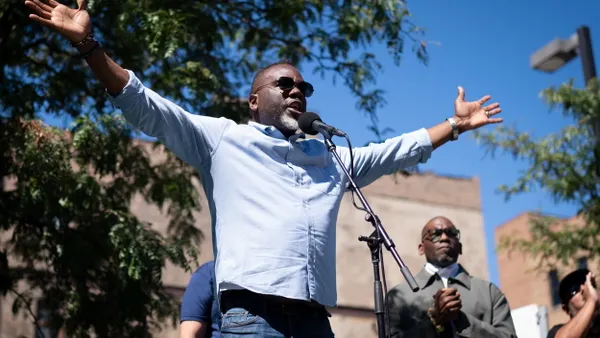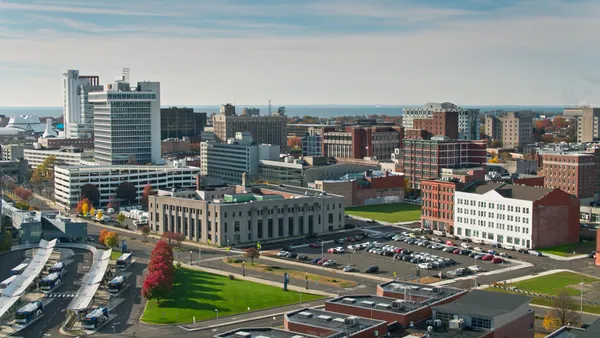From hurricanes, to wildfires to economic instability, cities need to be prepared for disaster. While cities are actively pursuing sustainability, they also need to pursue resiliency — the ability to bounce back from disruptive circumstances.
At a recent briefing on Capitol Hill, three experts — the mayor of Pittsburgh, a sustainability manager from Flagstaff, AZ and a program manager from the National League of Cities — weighed in on developing and implementing a resiliency strategy.
The advice from these experts came at an apt time, just two weeks after Hurricane Harvey, and while the west was battling wildfires and the southeast was discovering the damage from Hurricane Irma. Here, Smart Cities Dive distilled what the speakers had to say.
"We're talking about resiliency, and we’re looking at it through a lens of man-made failures, environmental failures, economic failures. We’re a model of a city that’s been able to bounce back from all three. The one thing we didn't do in any of those cases was prepare. We never built into the strategy of today the, 'what about tomorrow.'"
— Mayor of Pittsburgh Bill Peduto
The lesson: Don't just look backward. Look forward.
Peduto talked about the storied history of Pittsburgh, which includes environmental disasters from man-made pollution and an economic collapse from the decline of the steel industry. In developing Pittsburgh's plan for resiliency, OnePGH, Peduto said the city is looking forward.
The future is important to consider, especially as the effects of a changing climate are making themselves known. Weather patterns could change, forcing cities to deal with weather events, like droughts or floods, that they aren't prepared for. Climate refugees could overwhelm city services. Rising sea levels could permanently endanger the continued existence of coastal cities around the world.
Just as solutions from the 1920s might not work for problems in the year 2020, solutions from 2017 might not work for problems in 2080. Cities have to consider future conditions and look at the "what-ifs" of the future to ensure a strong resiliency plan.
"What we want to see is very much on community action. We believe that a successful climate action and adaptation plan requires our community investment and our community to be involved in the process. We want this to be the voice of Flagstaff, because we believe that success is only going to be achieved with our community members involved, our political leaders taking action and us creating an identity around our actions."
— Nicole Antonopoulos Woodman, sustainability manager, City of Flagstaff, AZ
The lesson: Get the community involved. Make them stakeholders.
Flagstaff, AZ is just a few hours north of Phoenix, but its climate is vastly different. Where Phoenix has to face intense heat, Flagstaff deals with heat, flooding and, because of the dense woodland around it, wildfires.
To deal with changing climatic circumstances, and with expected changes like decreased snow cover, more intense storms and more frequent wildfires, Flagstaff took a systems approach to preparing a climate plan. The city created a table laying out planning areas (such as forest management, public access and water resource), those areas' vulnerability ranking and and those areas' risk ranking.
For Woodman, one of the most important parts of designing a resilient city plan is communicating with citizens, to meet their needs and make sure there are no blind spots. When designing plans for city resiliency, Flagstaff has begun more and more to try and incorporate its citizens.
In order to incorporate those steps, Woodman demonstrated an outline that included broad commnity input, addressing vulnerable populations and using multiple channels of outreach. To further involve the Flagstaff community, officials also put together a community action group before issuing any requests for proposals, so that the community would be front and center.
"Do I see a trade off? Rarely. Usually the most sustainable, slash the most resilient solution, sort of presents itself and then the reality of financing, the reality of implementation, the reality of politics is the barrier. It’s not application of that theoretical definition. It’s not a tradeoff between the two conceptual things."
— Cooper Martin, program director for the Sustainable Cities Institute at the National League of Cities
The lesson: Don't let the theoretical block plans. The theoretical can enhance plans.
Martin defines sustainability as limiting humans' negative impacts on the environment; he defines resiliency as limiting the environment's negative impacts on human activity. While those goals may appear to negate each other, Martin reiterated that they are, in fact, complementary.
"I try to frame it in terms of goals, or metrics," Martin said. "This works whether you're a building owner, whether you're a city, whether you're a homeowner. It's something that you can set clear goals on."
Once a project or initiative that meets the criteria of sustainability and resiliency, Martin added, it's likely that there's a "built in" cost benefit analysis — which could speed up further project planning.











